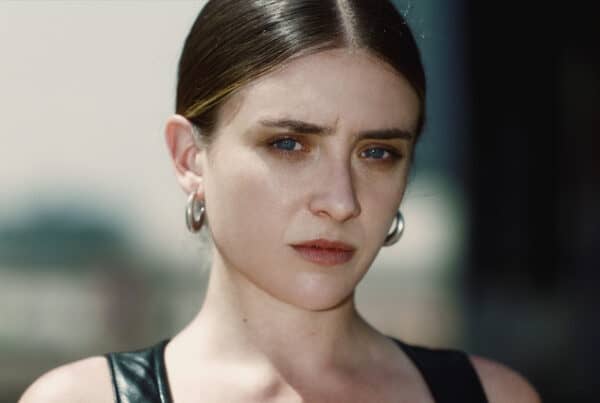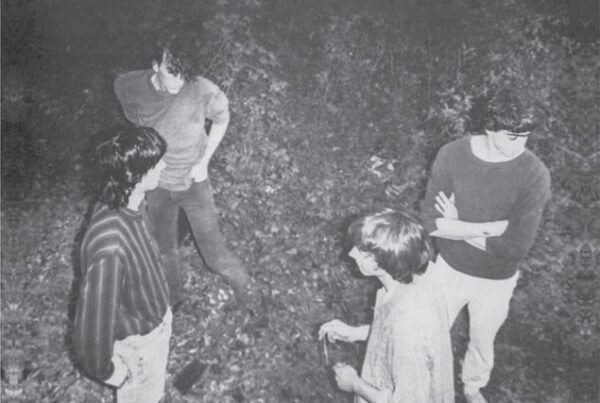For those familiar with role-playing games, Gus Englehorn is like the random encounter you bump into when fast-travelling.

Photo Credit: Kealan Shilling
You’re typically walking into a bandit ambush, or a nomadic merchant who’s set up shop. You’re confronted, however, with something more unexpected; a strange-voiced fellow leading a gang of rogues. You use perception: their collective posture, their attire, their lack of weaponry, point toward non-hostility.
Noticing in the background a collection of musical instruments, you put two and two together. A few quests prior, you overheard conversations regarding a gang of thrill-seekers in the snowy mountains, how their leader and a handful of others formed a musical troupe. Before you know it, the leader is renouncing himself a bard, offering his artistic services around a much-needed bonfire.
The bard is, of course, Gus Englehorn. Since 2020, he’s made a stark pivot from professional snowboarder to psychedelic rock artist. Primarily collaborating with his wife Estée Preda, the pair have concocted a strangely addictive rock’n’roll alchemy pulling from the likes of Pixies, Daniel Johnston and a dash of Ariel Pink.
Central to this alchemy is Englehorn’s voice, his left-field sprechgesang detailing stories of tarantulas, knights, and other medieval imagery. Despite calling Hawaii, Alaska, and Montreal home throughout his life, dreams are his most consistent base. In bed is where Englehorn manifests much of his material and where, from what I can tell, he joins me via Zoom.
The couple are currently staying at a friend’s apartment in Montreal. Soon they’ll embark on tour dates spanning Canada, and then America. There’s a mixture of anxiety and excitement. “I can’t even remember the last time I played a show.. Last summer? It’s been over a year, right? [Looking over to Preda] No, not a year, more like six months…. I’m scared!”
First came Death & Transfiguration (2020), then came Dungeon Master (2022), now comes The Hornbook (2025). The latter borrows its name from a medieval learning tablet while its content consists of Sgt. Pepper (1967)-esque exercises in psych-pop wizardry. In contrast to Dungeon Master’s firm fantasy setting, The Hornbook frequently melds past and future together, forming a sonic landscape resembling the medieval science-fiction of the Strugatsky Brothers’ Hard to be a God (1964).
Englehorn’s tales often comprise murder, metamorphosis, and romanticism. Take, for example, ‘Sweet Marie’. Inspired by an antique painting, the original composition depicts a noble couple – straight from Stanley Kubrick’s Barry Lyndon (1975) – conversing beside a sapphire river. Examining the composition while playing guitar, Englehorn reimagined the painting as a sinister story in which seduction turns to murder, the culprit drowning himself through guilt thereafter.
On a lighter note, ‘A Song With Arms and Legs’ highlights music’s ability to manifest ideas into sound, sound into experience, experience into memory. While ‘Rubber Ring’ by The Smiths appears an odd comparison, both songs capture the formative and lasting powers of songs; how human memory can be charted according to sounds, and one’s subsequent loyalty to those sounds as if they, too, had arms and legs.
This self-reflexivity was the product of a tough creative process. In the music video for ‘The Itch’, Englehorn & Preda recreate the writer’s block dynamics of Kubrick’s The Shining (1980). In part, Englehorn admits, the idea came from Preda’s resemblance to Shelley Duvall. He concedes, however, a level of truth in there – writer’s block did indeed shape The Hornbook’s early stages.
“About a year after Dungeon Master I hadn’t even finished one song! I write everyday so that was especially torturous. Eventually I went to visit my dad in Hawaii and he was living in this little shack with a toilet on the front porch, next to a pit with wild animals and boars. As soon as I got there, I don’t know what happened but I would just write a song everyday. The change of scenery just really coaxed it all out of me.”
In the same way Englehorn can’t pinpoint what transformed his creative process, the results are equally difficult to decipher As with previous projects, The Hornbook comprises standalone episodes connected in subtle, symbolic ways. Points of connection are never quite planned, or properly processed before written onto paper. “Deep in my spirit I feel everything has to stick together in a conceptual manner, you know? I never sat out to do that but I’m realising it’s maybe what my soul is aiming for.”
Behind this dadaist approach is an inherent creativity going back to Englehorn’s snowboarding days, as exhibited in the below videos:
Both videos compile low-resolution, early YouTube footage of Engle(horn) practicing his previous craft. Admiring comments reflect upon Englehorn’s unique snowboarding flair, reading:
@thedrew211207 – “sick part, I love his haggard pants with the baby shoe dangling from his leg. so classic”
@emptyguest6822 – “I hope he’s still rippin. He brought so much fun and creativity to the sport. Patchwork Patterns [the film in focus] changed my whole approach.”
The transition from snowboarder to musician was a difficult one; adrenaline, nature, and time spent with friends became cerebral, homebound exercises conducive to self-doubt. Alongside Preda’s ever-present support, as well as a life-long sense of tunnel-vision, Englehorn has found a way to transpose these doubts into artistic expression. “I guess there’s a lot of navel-gazing in there!”
It’s for this reason The Hornbook constitutes his most comprehensive project yet. Once reliant on releasing rapid-fire words and symbols into the sonic wilderness, the Alaskan / Hawaiian has settled into a strange groove; trusting, rather than doubting, his imagination.
The ethereal ballad dedicated to Englehorn’s father – ‘Roderick of the Vale’ – is simultaneously his favourite song on the project, and the first story he’s told from start to finish. It’s also the album’s clear fantasy cut. “Growing up in the nineties, if anyone found out you were into fantasy, your life was over. In a funny way, music’s become a liberation, it’s all just sort of quarred out of me after years of repression. Like, ‘Now it’s okay, man, you can like dragons and stuff.’”
In defying this repression, Englehorn is charting a “new map, of sorts.” Across 9 songs, The Hornbook immerses the listener within a world of side-quests and random encounters, blood-filled rivers and spooky forests, distracting one from a main story they’re not quite ready to finish.
Englehorn’s story remains similarly incomplete. In spite of occasional misdirections, ambushes, and the plain-old sensation of feeling lost, the nomadic bard remains committed to his newfound life, and charting new territory.
“The more I focus on music itself, the beauty within it, the less I think about the other side of things – like this spiritual practice; I just wanna be a monk, you know, this musical monk.”






